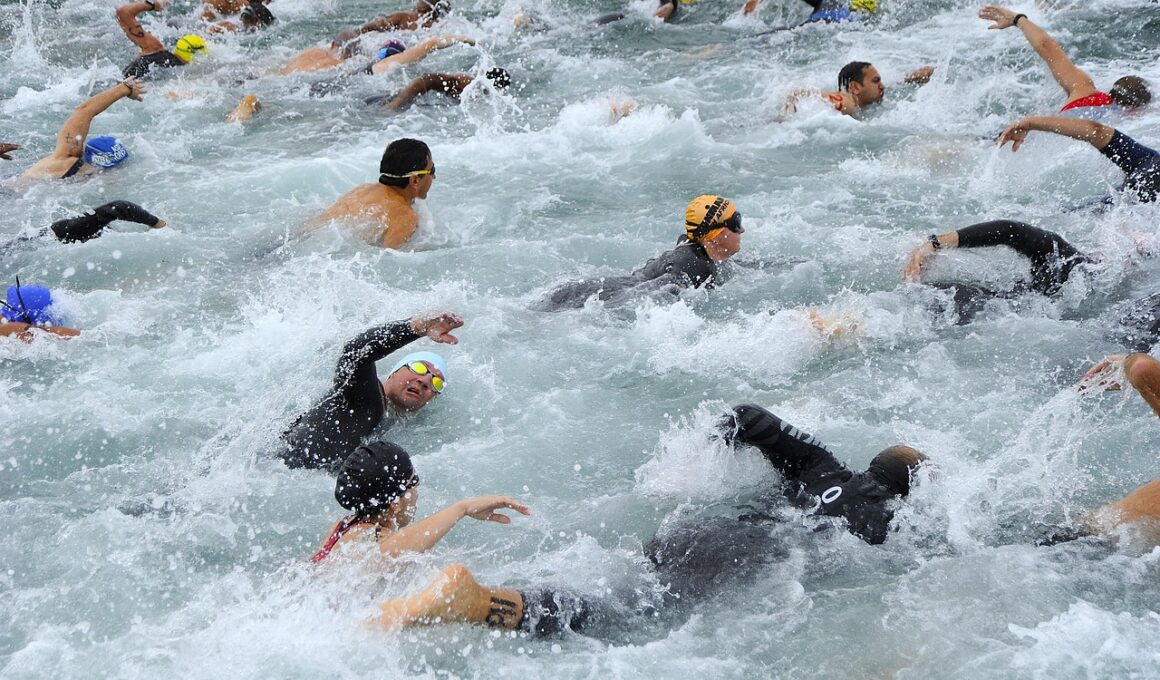The Impact of Transition Speed on Overall Triathlon Results
Transition training plays a crucial role in the overall performance of any triathlete. It’s not merely about swimming, cycling, and running; transitions between these disciplines can significantly impact race times. Knowing how to efficiently manage T1 (swim to bike) and T2 (bike to run) is essential for maximizing speed and ensuring a smooth flow. One of the primary factors affecting transition speed is practice. Integrating transition drills into weekly training regimens enables triathletes to refine techniques. This practice enhances muscle memory, allowing for quicker changes during the race. Athletes often overlook this crucial element, focusing solely on distance and pace, missing out on potential time savings. A well-executed transition can mean the difference of several minutes, showcasing the necessity of targeted training in this area. Consequently, incorporating transition-specific strategies can provide athletes with a competitive edge. This advantage is especially visible in a racing environment, where every second is counted. The right approach in training will help build this skill set, making it an integral component of triathlon preparation. By emphasizing transitions, athletes can optimize their overall performance and achieve personal bests.
The second critical element in mastering transition training is the physical setup. A well-structured transition area can significantly contribute to overall performance. Transition areas are often chaotic, which means that triathletes need to develop strategies to navigate this environment efficiently. For instance, arranging gear in an easily accessible manner is vital. Placing the bike, shoes, and other essentials in fixed locations allows athletes to act quickly without wasting precious seconds. Many triathletes also utilize specific tools, such as transition mats or clipboards, to outline their strategies before the race. Another consideration is the choice of footwear. Quick-lacing shoes or slip-on designs enable streamlined transitions. The psychological aspect cannot be ignored, either. Confidence is key; a well-practiced routine leads to increased assurance during the race. Triathletes should focus on visualizing their transitions ahead of the race, reinforcing their preparedness mentally. The training process should cultivate an efficient mindset. This transition training streamlines the athlete’s approach, letting them shift from one discipline to another with minimal disruption. By honing these elements over time, triathletes can see gains in their overall race performance, confirming the significance of transition training.
Aiming for Efficiency and Speed
Transition efficiency can dramatically influence the outcome of a triathlon. As athletes navigate T1 and T2, their ability to maintain composure while quickly executing changes dictates their success. Here are several approaches that enhance transition speed: Practicing consistently ensures familiarity with routines. Establishing a minimizing philosophy regarding the gear and necessary equipment can eliminate unnecessary junctures. Using designated transition zones provides structure and familiarity, preparing athletes for stress-filled race day scenarios. Ensuring that every piece of equipment is in its correct place saves time. Incorporating facets of the planned bike and run into practice transitions allows for seamless switching. Creating an organized environment can improve concentration, fostering quicker brain-to-body connections during transitions. Each of these strategies works collectively to ensure that the athlete remains engaged in the process while transitioning. This emphasizes the need to integrate transition training into the overall plan, ensuring that speed and efficiency translate into race day success. Ultimately, the enhancement of transition practices will directly reflect in recorded race times, making diligent training essential for aspiring competitors in triathlon events.
Another fundamental aspect relates to the mental preparation involved in effective transitions. A triathlete’s mindset during race day can heavily influence their performance and transition speed. Engaging in mindfulness techniques helps athletes maintain focus and minimizes mistakes. Practicing breathing exercises and visualization techniques prior to the race helps create a calm and controlled mental state. Establishing a clear plan for how to handle equipment and changes reduces anxiety when the participant arrives at the transition area. Having prepared plans boosts confidence levels, enabling athletes to control their emotions better. Triathletes also benefit from completing mock transitions during training to cultivate familiarity in mimicking real race scenarios. These mock sessions should include timing oneself in a controlled environment. Developing a routine allows for a consistent method that triathletes can follow regardless of diving into water or returning from the bike course. Consistency breeds success, positively impacting overall performance. Training for transitions is as vital as workouts for swim, bike, and run, and contributes to favorable outcomes in competitive settings. By focusing mental preparation, athletes can eliminate uncertainties that come with speed transitions.
Tools and Gear Optimization
The choice and arrangement of gear play pivotal roles in transition training. Ensuring that all essentials are accessible can significantly enhance transition times. For instance, triathletes might consider using elastic laces for their running shoes, which saves time since athletes engage in clipping shoes directly without tying. This simple tweak can lead to faster transition times, resulting in improved overall performance. Additionally, triathletes can organize their equipment strategically; having everything in a specific order creates a mental map to follow during the transitions. An organized transition space fosters clarity in high-stress situations, thereby reducing the likelihood of mistakes. Some athletes opt for specialized transition bags to easily store equipment, further enhancing organization aspects. It’s essential to gear not only for speed but for comfort as well. Selecting apparel designed for triathlon can also contribute positively to transitions. Rather than changing outfits, investing in multipurpose gear supports efficiency. Wearing one suit throughout the race eliminates precious minutes spent changing. This training area indeed must not be overlooked, as it amalgamates various elements leading to superior performance gains. The proper gear and arrangement can serve as crucial building blocks during training.
The final part of transition training incorporates the analysis and reflection after a race. Post-race assessments help athletes understand their transition speeds and areas requiring improvement. Reviewing performance involves timing each transition and identifying delays; meticulous breakdowns enhance learning experiences. For instance, recognizing patterns in mistakes during transitions can lead to informed adjustments during future training sessions. Utilizing tools like video analysis or simply recording transitions can create valuable insights. Evaluating these factors leads to strategic decisions and adjustments; these impact future training endeavors positively. Engaging in coaches’ feedback enhances this reflective process, allowing different perspectives to shine light on potential areas for enhancement. This helps build a holistic view of performance, which is essential for long-term improvements. Incorporating feedback loops promotes awareness and accountability in the training process. Furthermore, engaging with fellow triathletes in discussions about their transitions fosters learning; shared insights can motivate and inspire quick adaptations. As triathletes adopt a continuous improvement mindset, the discipline’s complexity transforms into manageable components. Overall, embracing post-race reflection will significantly inform athletes’ approaches to their transitions, thereby enhancing their triathlon results.
The Overall Importance of Transition Training
Transition training is undeniably a critical aspect of triathlon preparation. The cumulative effects of efficient transitions can set apart competitive athletes from those who train solely for the swim, bike, or run elements. Throughout this article, we’ve discussed how mastering transitions leads to better race results. With limited training time, consolidating transition skills can yield substantial performance gains. Thus, effective strategies emerge as prominent factors influencing race outcomes. Integrated training plans that prioritize transition workouts ensure that athletes develop their abilities holistically. The learning derived from enhancing transition speed is invaluable; it promotes efficiency not only within competitive settings but also during training. Additionally, developing skills around transitions enhances resilience and adaptability, qualities essential in the world of triathlons. Therefore, athletes should seek to make transition training an enjoyable part of their regimen. It fosters community stature and encourages camaraderie among competitors, creating a supportive atmosphere for sharing insights and experiences. At the end of the day, the impact of a well-prepared transition extends far beyond seconds saved; it shapes a triathlete’s journey toward competing successfully and realizing personal bests.


